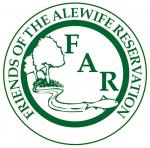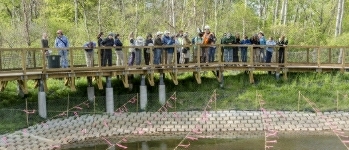Commentary: What killed the geese at Alewife?
By Kathy Johnson, Friends of Alewife Reservation
Posted Apr. 2, 2014 @ 12:50 pm
Updated Apr 2, 2014 at 12:54 PM
ARLINGTON
Canada geese are extremely visible and 'in your face', and mostly considered a nuisance.
We often don't notice their regal stance and graceful flight in perfect V-alignment whereby we know spring is here or winter is on the way.
In flight, male and female honk in sequence, indicating their instinctive manner of migration and love of life. As a child, a goose approached me and bent his long graceful neck, then lightly bit my big toe. It looked up at me, and eye-to-eye we recognized another kindred creature in each other. Stunned, not hurt, I got the point. It was a diplomatic gesture of territory and I never forgot the magical admiration I felt for the wild goose flying long distances in perfect alignment.
There are many geese at Alewife Reservation. This winter I counted crowds of geese at the confluence of Alewife Brook and Little River, an ideal spot that supplies the wetlands they love, surrounded by shrub and forested upland that suits their breeding habits and provides privacy.
Canada geese, like red-tailed hawks, are less migratory than many birds, and geese prefer the same nesting grounds on small elevated land areas, often near muskrats, and their water source is plentiful across from Alewife T-stop at the entry bridge to Alewife Reservation.
In mid to late spring they begin a kind of 'dating' or pairing off for walks and exchanges of affection. Sexual maturity arrives during their third or fourth year. They are fiercely monogamous for life after that. The death of a mate may result in a whole season of mourning. The remaining goose may not seek another mate. Such is the bond.
The female stands near her chosen mate constantly until the male becomes aware he's ‘the one', and bond is complete. A nesting site may be found before the bonding. At night, there is a mating dance involving neck and beak. Geese will seem to disappear as they create an average of five eggs which incubate in around 28 days. Chicks communicate while still in the egg with chirps and taps which Canada geese are famous for.
While mom sits, dad protects. He is determined, smart and will die for the nest. When family is safely grown he will be less aggressive.
When chicks hatch, they connect with other parents forming a communal group where younger geese are taught the ways of the world. They move around fields to graze clover, seeds, and berries and grass seed. Goose poop is organic and biodegradable, although it can contribute substantial nitrogen and phosphorus to waterways, but settles quickly into sediment.
The group behavior continues until goslings quickly achieve the small adult goose look perhaps in one year. Siblings and cousins join other groups at that time, wandering further from the parent geese. Teen-age like gangs are high-spirited and seek adventure, often arguing and splashing vigorously. Families continue to stay connected in various forms throughout the life of the goose.
Sadly to report, myself and companion observed three dead geese at the storm water wetland oxbow designed for Alewife spawning and Little River observation. We now work to insure our wildlife around Little River remain healthy and unfettered by dangerous bacteria, metals or human carelessness which can also affect humans. No indication of natural predation was found from fox or coyote. A dead opossum was also discovered.
A wide oil slick was visible and showed up in the city's water quality test. The Department of Conservation and Recreation removed the carcasses.
Maintenance is critical to the future of the wetland and all should report their observations to Friends of Alewife Reservation, 617 415-1884, or info@friendsofalewifereservation.org. FAR and supporters hope to know the source of death of the wildlife creatures very soon.
Kathy Johnson visits the Alewife Reservation every day, and reports her observations to the Friends of Alewife Reservation
Preserved 2014-04-17 from Arlington.WickedLocal.com / Arlington Advocate at
http://arlington.wickedlocal.com/article/20140402/News/140409095/?tag=1
- Home
- Directions
- FAR Wildlife Blog
- Calendar
- News
- Donate Now
- Get Social!
- Storm Water Wetlands
- Plants and Restoration
- Photos
- Videos
- About & Projects
- Master Plan for Alewife
- Archive
- Newsletters
- Contact
 Presentation Spotlighting Alewife Reservation
Presentation Spotlighting Alewife Reservation
 Follow us on Twitter
Follow us on Twitter
 Like us on Facebook
Like us on Facebook
 Follow us on Instagram
Follow us on Instagram
Forward our web address to a friend!
- An Urban Gem - Alewife Reservation Nature Preserve
- Envisioning The Silver Maple Forest
- History and Policies of Cambridge, Belmont, and DEP
- Storm Water Wetlands
- Friends of Alewife Reservation brochure
(front, back) - Technical Analysis of Upper Alewife Basin
- Watershed: An Excursion in Four Parts
- The River Is A Restless Spirit: Life in the floodplain forest
-
Assessment of Silver Maple forest for DEP Adjudicatory hearings and
Patrick Fairbairn, author of the Assessment - Community Native Garden Flora
The
Alewife Reservation
is a unique natural resource for the communities of Belmont, Arlington and Cambridge
and home to hundreds of species, including hawks, coyotes beavers, snapping turtles, wild turkeys and muskrats,
the reservation is a unique natural resource for the community.
Historical information (Powerpoint)
Friends of Alewife Reservation works to protect and restore this wild area and the surrounding area for the water quality, native plants, animals and over 90 bird species with paths for walking, running and biking, recreation, and for classroom education and research. We regularly steward and preserve the Reservation area for wildlife and for the enjoyment of present and future generations.

(video)
By-Laws
About Friends of Alewife Reservation
Statement of Purpose
Citizen Forester newsletter archive
The Birds of the Cambridge Region of Massachusetts

by William Brewster 1906
Nuttal Ornithological Society
Biodiversity Study of Alewife Reservation Area: Species, Habitat, Ecosystems

Inventories by David Brown, wildlife assessor (2003, 2004.) Published by and available from FAR for $10. Write or call for your copy. (sample)
Updated Dave Brown Inventories (2008, 2010)
Inventories of Alewife Reservation Wetland Plants by Walter Kittredge, Botanist (2013)

